When we were visiting Taiwan, I found myself incredibly car-sick. I’m not sure what it was… I think a combination of jet lag, being really hungry, and being stuck in a car that was swerving side to side constantly while stopping and going abruptly (*cough* Uncle’s driving *cough*). Well, after being stuck in the car for 4 hours, on winding roads, partially in rush hour traffic… we finally arrived at the Raohe Street Night Market in Taipei. I stumbled out of the car, barely able to walk… my nauseated stomach churning… and we began to walk through the market. Boom! The smell of stinky tofu hit me, and I thought I was going to pass out. Motion sickness + strong smells = NOT a good combination!
We left the night market to find an air conditioned place to sit down so I could recover. After walking a few blocks, my father-in-law motioned us inside an empty Dim Sum restaurant. My husband tells me (in English) that we are going to order some food and tea so that I can sit there in the air-conditioning, and let my stomach calm down. Empty restaurant, so food must not be that good, right? WRONG! The food started to come… Shrimp Har Gow, Pork Siu Mai, Fried taro balls… and some type of steamed custard bun that I had never had before. My husband ate all of them, and ordered more! Finally I was starting to feel better, and the second round of custard buns came out to the table, hot and fresh. I bit into one… and OMG. Probably the most delicious custard I have ever tasted in my life… sweet with a hint of saltiness (similar to the amazing salty-sweet combination of salted caramel) and the custard oozing like lava out of the steamed bao. Words can not express how that bun made my horrible day 100% better!
So of course, figuring out how to make these buns became my latest mission! But first, I needed salted duck eggs – I didn’t have any! So I did the next best thing, and began the process of making my own salted eggs, with chicken eggs… but it would be another 30-40 days before those would be ready. (Try my Homemade Salted Egg Recipe!) Luckily, my friend was headed up to Orange County to go grocery shopping, and she picked up some salted duck eggs for me. (Now normally, I don’t like salted eggs. My husband LOVES salted egg yolk in moon cakes… but I don’t. But trust me – this custard is different – even a salted egg hater like me can’t get enough!)
Since my first few attempts, I have made these buns several times – perfecting the recipe as I go – and I didn’t find much of a difference in the custard between my store-bought salted duck eggs and my homemade salted chicken eggs. One of the most important tricks is to freeze the egg custard portions solid before wrapping in dough and steaming. I cannot emphasize this enough. If you do not use frozen custard, the custard will cook to a gummy thick custard consistency (instead of being molten lava like custard), and it will explode out of the bao – you will have a mess. (Unfortunately, I know this from experience. Lol.)
You can buy instant nonfat dry milk powder in the baking aisle of your regular supermarket. It doesn’t need to be nonfat – but that’s what I had, so that’s what I used. Custard powder is a little bit harder to come by in the USA. You can buy Birds Custard Powder online… I actually found Clabber Girl Custard Powder at the 99 cent only store (go figure… I guess it’s unpopular?). If you have an international or British Market near you, they usually have custard powder. It comes in a can, about the same size of a baking powder can. (But if all else fails, I think instant vanilla pudding powder might work out as a substitute.)
Update 10/24/12: I forgot to explain the flour in this recipe! Normally steamed buns (baos) are made with a special flour in Asia called “Hong Kong Flour“. It’s a highly bleached flour, with a slightly lower protein (gluten) content than regular all purpose flour. Bleached flour is what produces that nice bright white color of baos, and the lower protein content gives the bao that soft fluffy texture with just enough structure to hold it up after steaming. Most of the all purpose flour here in the United States is unbleached and higher in protein, so you will need to combine all purpose flour with (lower protein) cake flour to create the right protein level in the dough. Also, cake flour is bleached, so it will also help to whiten your buns… but since there is still some all purpose flour, your buns may still have a slightly beige tint to them. If you have access to White Lily flour in your area (Southern or Midwestern USA), definitely use that instead! If not, then use my combination of all purpose flour and cake flour. (And of course, if you can find Hong Kong flour… then use that!)
Salted Egg Custard Filling:
- 6 salted duck or chicken eggs
- 1/2 c. + 2 T. sugar
- 6 T. custard powder
- 1/2 c. instant nonfat dry milk powder
- 1/4 c. coconut milk
- 1 T. cornstarch
- 1/2 c. unsalted butter
Bao Dough:
- 1 1/2 c. all purpose flour
- 2 1/4 c. cake flour
- 3/4 tsp. salt
- 3 tsp. active dry yeast
- 3/4 tsp. baking powder
- 3 T. sugar
- 2 T. canola oil
- 1 c. water
1. A day ahead of time, make the custard filling. If you have raw salted eggs, boil them for 10 minutes until fully cooked. Peel, and discard the shells and egg white so that you have only the cooked salted egg yolks. Mash the cooled cooked egg yolks.
2. In the work bowl of a food processor, pulse the egg yolk with the remaining custard filling ingredients until smooth. (If your butter melts, you might find the custard filling to be somewhat runny at this point – don’t worry! It will firm up when chilled.)
3. Refrigerate the custard filling until cold and firm (several hours). When firm, use a cookie scoop to scoop out and divide the custard into 18 portions. Place the custard balls onto a plate, and cover with plastic wrap. Put in the freezer overnight until frozen solid. (I lined my plate with Reynold’s non-stick foil, for easy removal.)
4. Place the sugar, salt, oil, and water in the bottom of the bread machine pan. Top with the all purpose flour and cake flour and baking powder. Make a little depression into the flour, and add the yeast. Turn the machine on to the “basic dough” setting. (Or, you can knead the ingredients together, then let rise 1 hour and punch down, and rise again for 30 minutes.)
5. When the dough is ready, divide into 3 portions. Set water to boil in a steamer. Take one portion of dough and divide into 6 pieces.
6. Flatten the dough pieces with your hands, and place a frozen custard filling ball in the center.
7. Pinch up the sides of the dough to completely enclose the filling.
8. Spray paper cupcake liner bottoms with a little bit of non-stick spray. Place one prepared bao in each liner, seam sides down.
9. Steam the 6 baos for about 8- 10 minutes until done. (Do not overcook, otherwise the custard filling will explode out of the bao and you will get a stiffer custard filling instead of the lava type custard filling.) Serve immediately. Repeat with the remaining dough and filling. (If you don’t want to make all the baos at once, you can leave the frozen custard balls in the freezer for a few days, and the bao dough will also keep in the refrigerator for up to 3 days – covered with plastic wrap.)

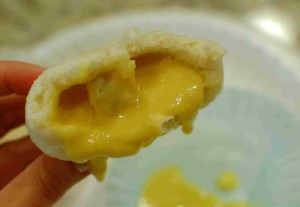
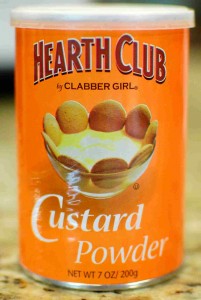
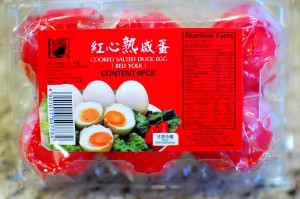
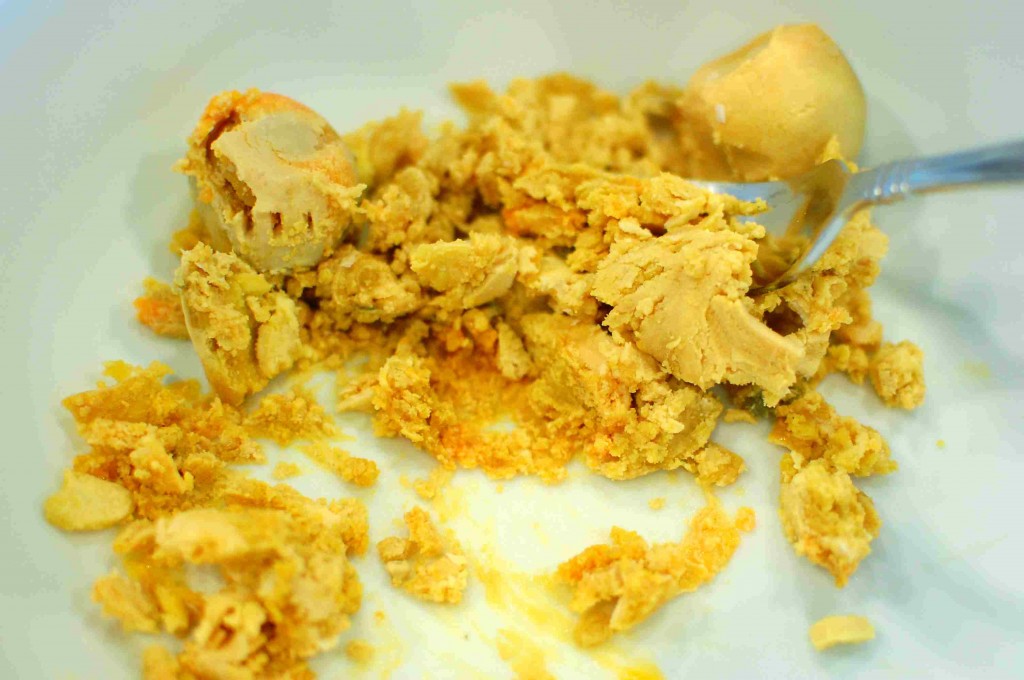
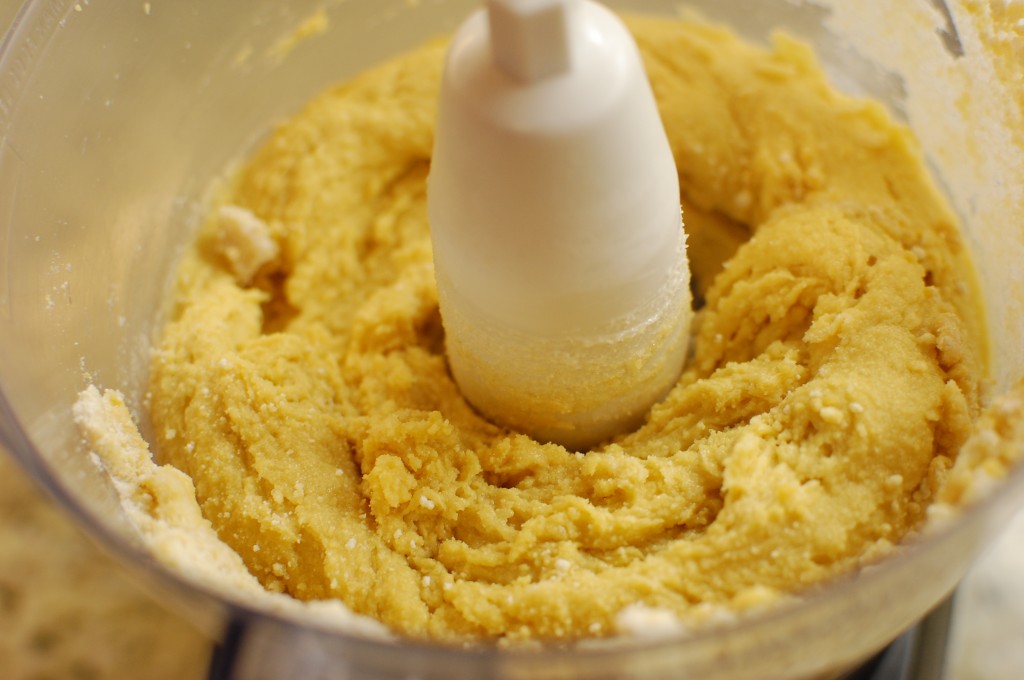
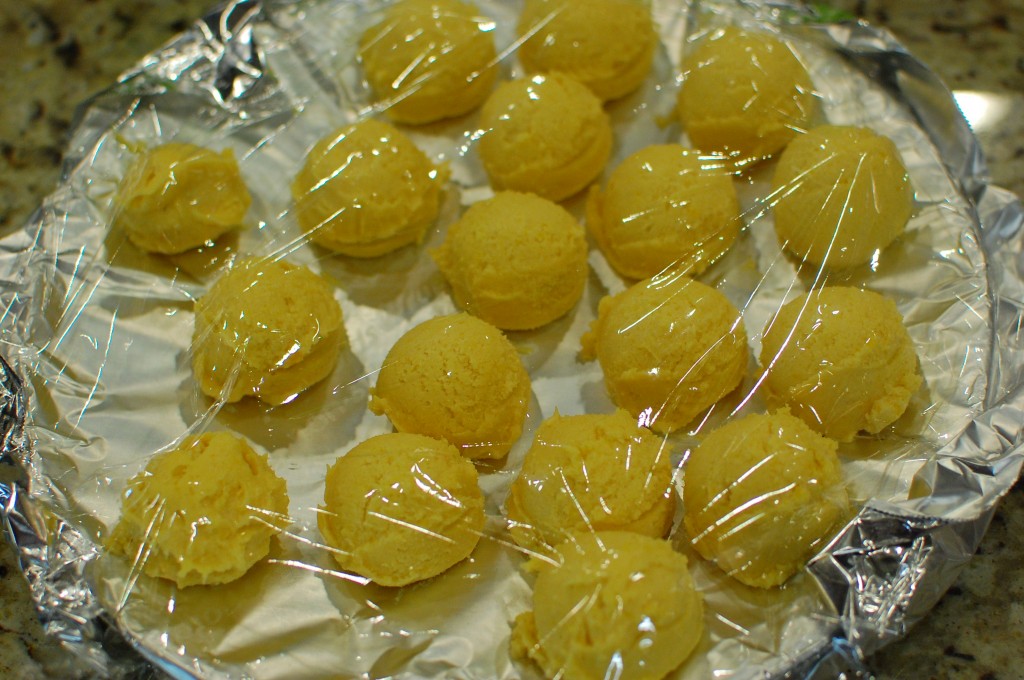
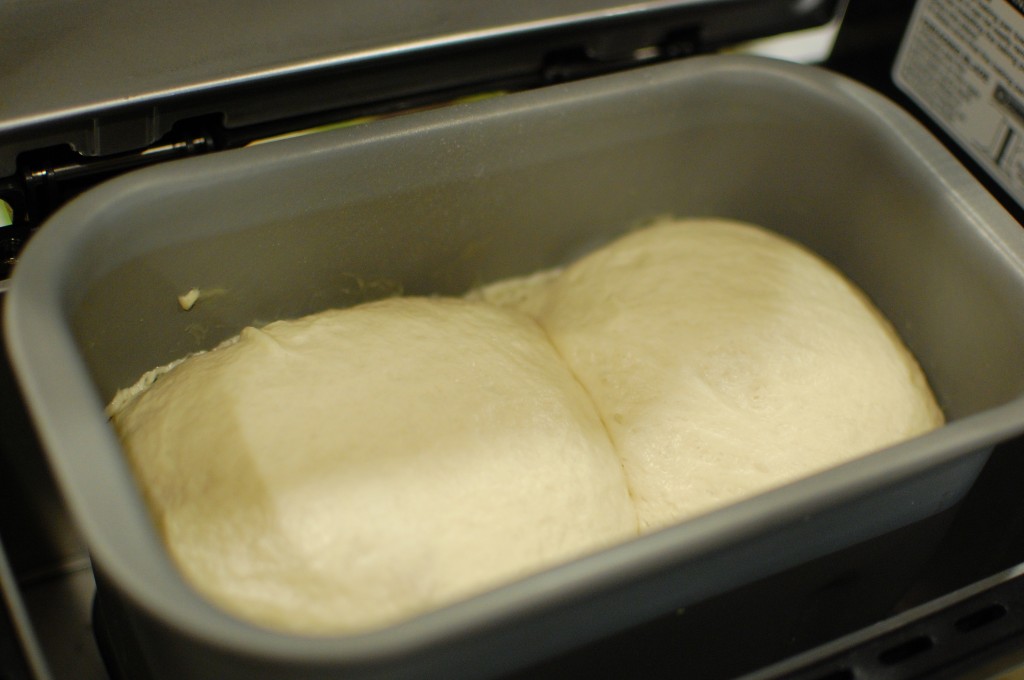
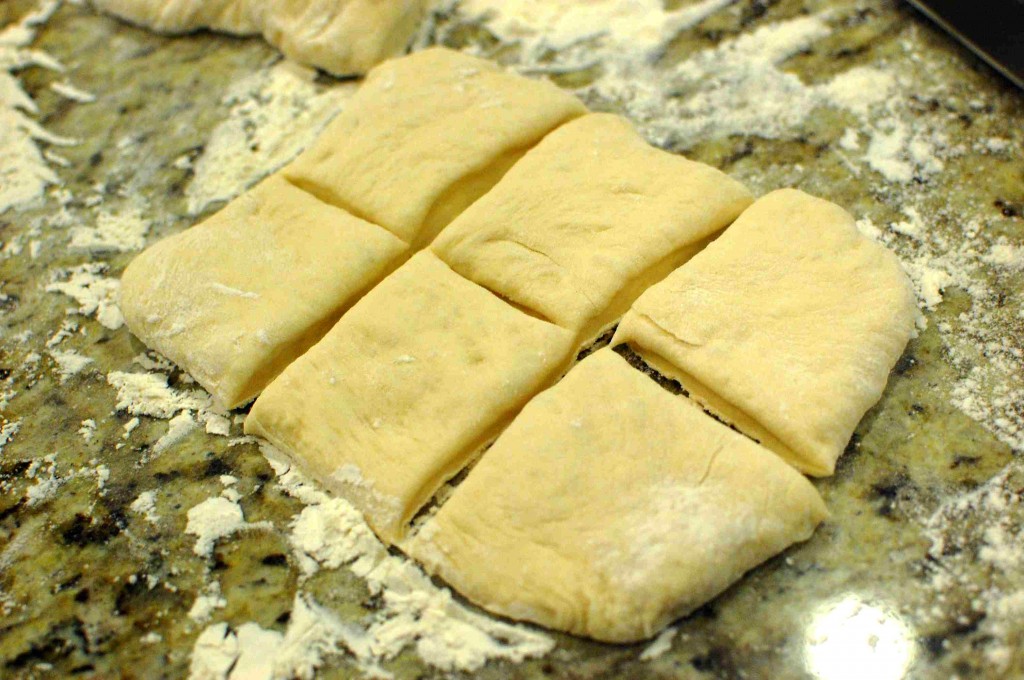
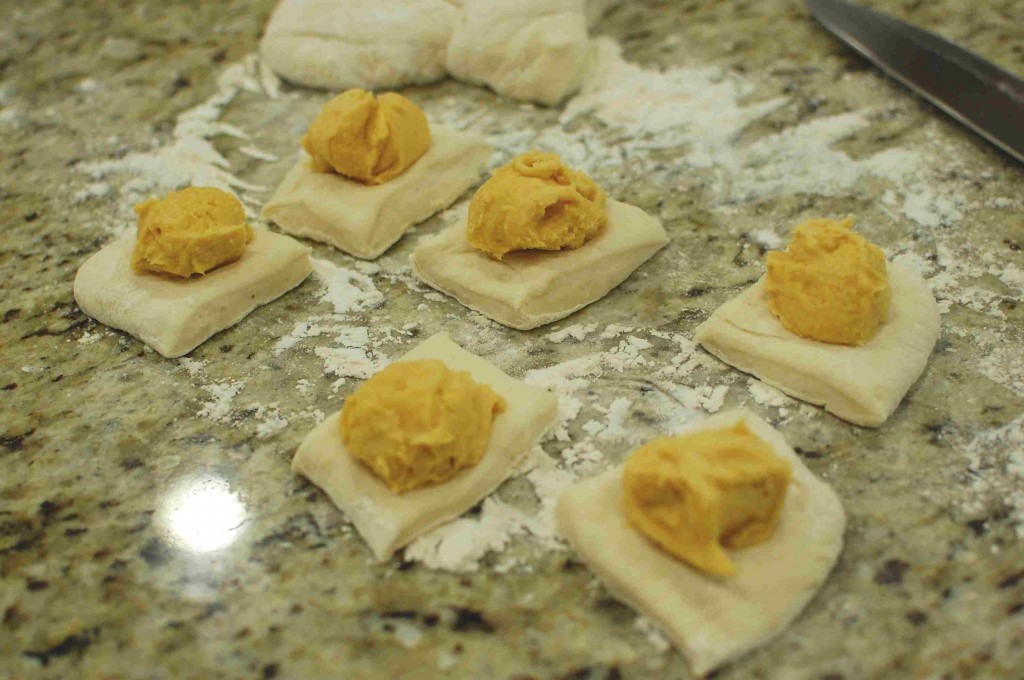
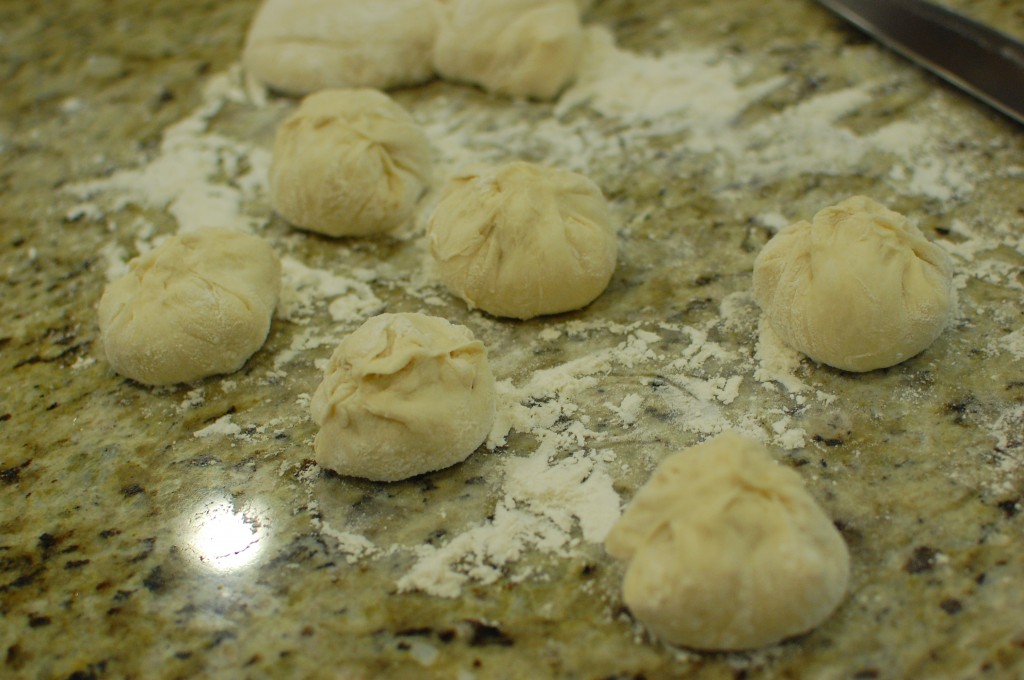
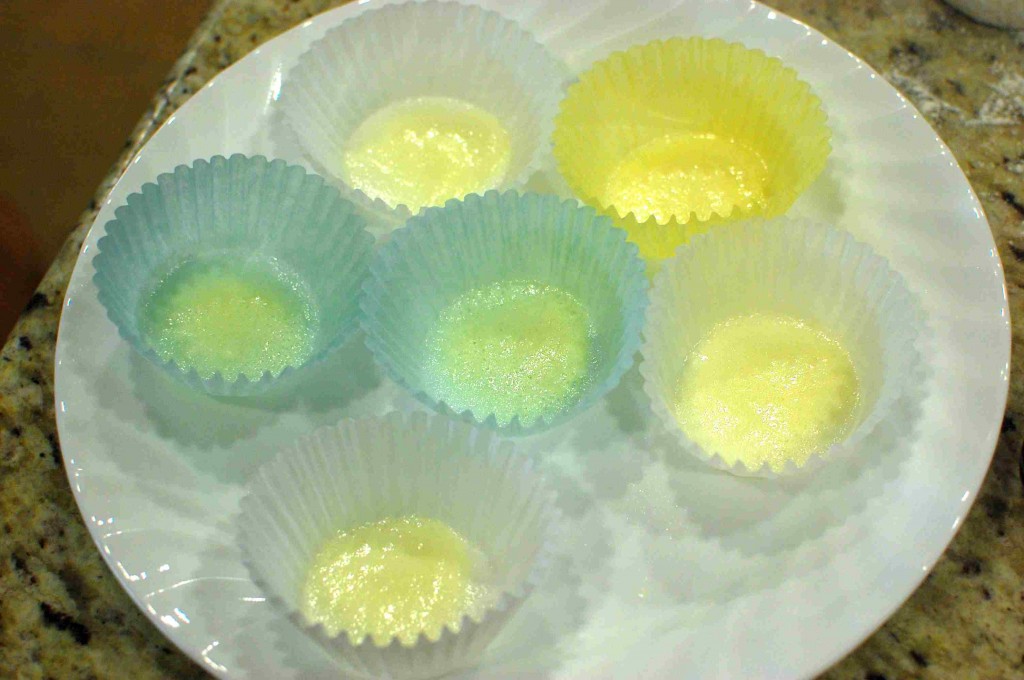
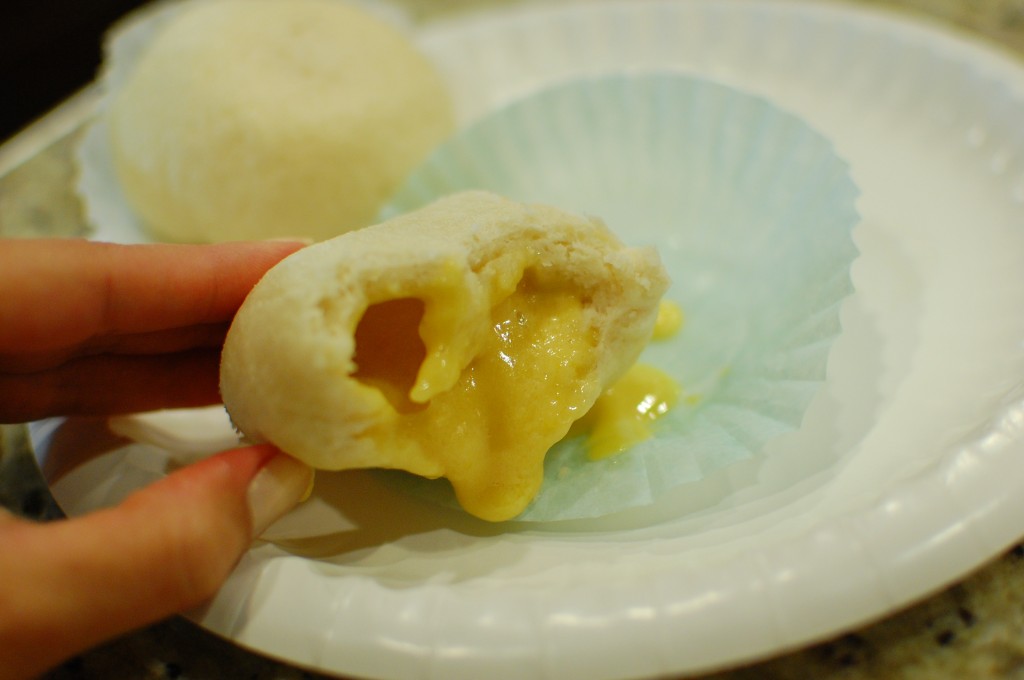


This look so delicious! I tried them before in a Chinese restaurant once and they were delicious! I always wanted to learn how to make them! Thank you for the recipe! Now I can learn how to make them.
I had always wanted to make them but got no recipe. Thank you for sharing this! I love liu sao bao,and I have been eating this my entire life.
Thanks! Let me know how it turns out for you!
These sound delicious!. I know some people who aren’t used desserts that include entire salted egg yolks and it freaks them out. I had a classmate in elementary school who was horrified and thought the bakery made a mistake right before she tossed it in the trash. What a shame.
can you please write clearly the unit on measurement? what is “T”, “c” etc
Hi There! All my recipes are in standard volumetric (U.S.A.) measurements.
The following are the standard volumetric measurements:
T. = Tablespoon
tsp. = teaspoon
c. = cup
Hi! I tried makign this but the dough taste too doughy… perhaps i didnt put it in the steamer long enough?
Several things could have happened.
1. You want to make sure the water in your steamer is boiling when you start cooking the buns.
2. You want to make sure that you portioned your dough into 18 pieces, no less. If you use more dough, or make the buns larger, they will take longer to cook.
3. You don’t want any large lumps of dough – make sure the dough is flattened before you fill with the frozen ball of custard, so that you have a thin layer of dough surrounding your filling.
4. Do not overcrowd the steamer. You only want to cook 6 buns at a time, no more.
Hope this helps!
I did use Hong Kong flour instead (it’s readily available here) but I also made one minor adjustments to your custard recipe. I feel that the liu sha baos that are made in hong kong have a nursery sweetness, so I added two heaped tablespoons of condensed milk into the custard mix. It helps bring out the flavour in the milk powder, and it really works!
All in all, a great recipe. Thanks for sharing!
Hi Gerald,
Thanks for the feedback! I’ll have to try adding some condensed milk next time!
Hi Mika,
your mixture of 1.5 cup ap flour plus 2.25 cup cake flour, is it roughly translate to be equal to HongKong flour? (in term of % in protein?)
I meant if another recipe calls for HongKong flour, can I use your flour ratio (1.5 c ap flour and 2.25 cup cake flour) to replace it? Also I was thinking if you want your bao to be whiter, you can use bleach ap flour and cake flour mix together. But then I heard that bleach flour doesn’t taste as good as regular ap flour
Hi Amy,
If you found Hong Kong flour, then I would substitute about 3 1/2 c. Hong Kong flour, and add the extra 1/4 cup if the dough is too sticky. Actually, it is best to use bleached AP flour if you can find it (instead of regular AP)… that makes the bao whiter, and the flavor isn’t really affected by it. The problem is that I live in an area where people are extremely health conscious, and you can NOT find bleached flour anywhere! So if you found the real thing… Hong Kong flour is best. If not, then bleached AP flour + cake flour is second best.
Hi Mika
I tried out your recipe today. It turned out rather well. I really like the filling . Sweet and salty. However, the dough doesn’t seem to rise much after been steamed and not as fluffy or soft as I would imagine with sa-chiu bao (sp). Is it how it is supposed to be ? (I never have this at the bakery before so really don’t know how to compare. ) Again , thank for posting the recipe
Hi Amy,
The dough on this one will be as thick as you want it to be. If you want a more bread-y bun, then increase your dough to filling ratio. Because this is more of a dessert – I like a medium amount of dough to filling, but it shouldn’t be thin, and it should definitely rise a bit. Maybe check your yeast and make sure that the dough rose the first time around.
after putting the filling, can I still “proof” the dough to have a fluffier dough? thanks…
You could… however, if the filling defrosts, you might find that your baos explode during the steaming process. So make sure your filling is frozen solid if you do this… and don’t let the dough rise too long. Watch your steaming time, and if you see the first one explode, immediately remove from the steamer!
these look great! I would like to put this filling in a muffin or something like that though – does the filling stay molten at room temperature?
As long as you don’t overcook them, the filling does stay somewhat molten, even at room temperature. However, they taste best when hot and fresh, so the center is truly ‘molten’ – like lava.
I’m not sure how it would work as a filling in a muffin though – but you can try it. Let me know how it turns out!
Hi Mika,
What’s the different between ‘custard powder’ and custard flour.
Thank you for sharing this delicious recipe. I will try it.
I’m not sure? I’ve never heard of ‘custard flour’ before… custard powder is sold in a can to mix with ingredients to make custard. It could be the same thing… what do the instructions on the packaging say? Does it say something like mix with milk and sugar, and heat? If so, then it’s probably the same thing. You could always try it and see if it turns out…
Hi Mika, I can’t find cake flour in my local grocery shop, is it the same as corn flour?
No, cake flour is a type of wheat flour… It’s just lower in protein, so it makes for a softer, more refined texture. If you can find cake flour, you can substitute with all purpose flour + cornstarch.
1 cup cake flour = 3/4 c. All purpose flour + 2 T. AP flour + 2 T. Cornstarch.
For this recipe though… it’s best to use cake flour (which is bleached)… because texture wise, it will give a better bun result. If you cannot find cake flour, consider using Hong Kong flour (if you can find that)… at the very least, try to use a low protein bleached flour.
Thanks Mika, I’m just a bit confused… whats AP flour? I thought that was abbreviated “all purpose” flour! So sorry, I’m not very experience cook :S
Yes, “AP flour” is “all purpose flour”… I was just abbreviating it.
Hi Mika,
Is there a substitution for the instant non fat dry milk powder? Also, can I use a whole wheat flour for the cake flour?
You can try powdered non-dairy creamer instead of milk powder… but I’ve never tried it, so you might have to experiment. As far as whole wheat flour, no, do not substitute. Whole wheat flour will ruin the texture of the bun.
Hi, i was wondering, how can i re-heat the left over paus without causing them to burst?
Wrap them in a damp paper towel, and microwave for 15-30 seconds. That should do it!
Just fyi, they sell packaged salted egg yolks. No need to buy whole salted eggs. Thanks for the recipes.
I’ll have to look for those next time!
Can I use a stand mixer with a dough hook attachment instead of the bread machine? If so, what do I do with the yeast? Can I still add the yeast with everything else just like in your instructions or do I need to put the yeast in warm water first? And also, how long do I mix the dough for?
Yes you can. Just dissolve the yeast into the 1 c. water called for in the recipe for 2-3 minutes before mixing all the dough ingredients together first. Do not add any additional water to the recipe – doing so will alter the ratio of liquid to dry ingredients and give you a dough that is too sticky to work with. I would probably mix the dough for about 15 minutes give or take – however long enough to achieve a “windowpane” effect when stretching the dough between your fingers.
hi why does some recipe ask for cornstarch in the custard filling? which do you think is better milk powder or cornstarch? hope you could help me, thanks
My recipe calls for both cornstarch and milk powder. Neither is a substitute for the other – they are for different purposes. The purpose of the cornstarch is to thicken the mixture. The purpose of the milk powder is to provide a creamy texture without making the custard watery (which you would get if you used actual liquid milk or cream). So to answer your question, neither ingredient is “better” – they are both necessary to get the desired texture of molten custard in your final product.
Thank you very much for posting this recipe. I made this last week, it turn out pretty good, except the bao was not as fluffy as I wanted. I followed the exact measurements… Any idea why this might be happening? By the way, what is Hong Kong flour?
The dough on this one will be as thick as you want it to be. If you want a more fluffy bun, then increase your dough to filling ratio (use more dough to wrap the frozen filling). Because this is more of a dessert – I like a medium amount of dough to filling.
Hong Kong flour is a lower protein bleached flour – about 8-10% protein. (In comparison, cake flour is about 6-8% protein, and all purpose flour is about 10-12% protein.) HK flour is used to make soft (and bright white) fluffy steamed baos. If you do not have access to Hong Kong flour, then you can use the combination of bleached all purpose flour and cake flour listed in my recipe. It’s better to use a bleached AP flour rather than unbleached… but if you can’t find bleached AP flour, you can substitute with unbleached… your dough will just not be as white and may be a bit chewier.
Hihi!
Thanks for sharing your recipe
Could you advise what is a good substitute for Active Dry Yeast? Can’t seem to find it in the local supermarkets.
Basically, any powdered (dry) form of yeast granules. Where do you live? Most supermarkets sell small jars or envelopes of yeast in the baking section.
Hi, thanks for the recipe, can i use it for bread bun filling and bake it instead? if yes, how do i prevent the buns from exploding while proofing with the fillings in the bun or baking it? Thanks!
You can try? I’ve never made it that way. I have a feeling that the longer time that would be required to bake the buns would make the filling harden – so you’d end up with more of a thick filling than molten lava like filling. Plus they might explode. The trick to make this filling the right consistency is to freeze the filling right before filling and cooking. So if you then let them sit out for the buns to rise… the filling will be melted, and they will probably harden and explode when baking. Maybe try baking them immediately instead of allowing a second rise… but I’m not sure if this will work at all or not.
The filling is excellent (had to resist eating it out of the bowl), though it was completely liquid by the time I finished with it. I didn’t have a scoop anyway so I thought I’d be clever and freeze them in ice cube trays – no, don’t try that. It makes nice portions but the egg goo remains sticky when frozen making it hard to remove.
The dough… this recipe probably works well for a bread machine, but making it by hand it wasn’t quite right. Used the AP/cake flour mix (there is no HK flour even in Asian grocery stores here), exact measurements, and dough was far too dry. I make bread a lot so I managed to save it with a little improv, but it was still hard to seal the baos. It turned out pretty good despite the goo-splosions from my not being able to seal the baos properly. Tastes great in the end. I have to go eat the delicious egg off various surfaces of the kitchen now…
Well, don’t forget that you have to account for atmospheric conditions and temperature/humidity when making bread. If you found the dough to be to dry… then make sure you add a little extra water (1 T. at a time). I’ve never had the dough turn out too dry in the bread machine – but keep in mind if you are hand kneading and adding flour to keep it from sticking, that extra flour will stiffen up the dough quite a bit – so keep this in mind and add a bit more moisture to start with.
Hi, I tried your recipe yesterday and it was a success! I find salted chicken eggs’ yolks are a bit smaller than Duck eggs. I used chicken eggs this time but I plan to use duck eggs in my next attempt.
You can use duck eggs or chicken eggs. I can’t easily get duck eggs around here, so I just go with chicken eggs. But if you have easy access to duck eggs… go with that!
Is it possible to make the filling without a food processor?
Yes, you can mash it all up and combine it with a fork… but it will take a lot longer – make sure you have it thoroughly combined.
Hi,
Thanks for posting this recipe.pls clarify my doubts:
1.what you mean by all purpose flour? Can you tell me which flour it is?
2.can I use microwave for bread machince.
All purpose flour is a medium protein flour that we use here in the USA for most home baking purposes.
I’m not sure what you mean about using the “microwave for bread machine”? I use a bread machine in this recipe to do the kneading, mixing, and rising of the dough – not for cooking or baking it. A microwave will cook your ingredients, not mix and knead them together. In any case, no, I wouldn’t use the microwave for this recipe – it will work much better if you steam it.
I want to send you an award for most helpful innertet writer.
Hi Mika,
I’m uncertain if you’ll be seeing this. Sincerely hope that you’ll get back to me. I would like to ask, what is the temperature for the lukewarm water? To specify my question, i would like to clarify them in degree Celsius, as my country does not measure temperature in Fahrenheit. I seems to always have problems with proofing my dough that caused a harder dough and most of the time it doesn’t raise. I’ve checked my yeast, they’re aren’t expired. Would appreciate your help to try this recipe out.
Thank You
The easiest way to make the dough is to use a bread machine… it has a warming step which heats the ingredients to the correct temperature. If you are mixing the dough by hand though, you definitely want to use “lukewarm” water. What is lukewarm? Basically, you run the tap, and when the water feels mildly warm and no longer cold – that’s lukewarm. I don’t really have a measured temperature to tell you… If you were drinking hot tea or coffee, and it was still slightly warm (but cold enough that you don’t really want to drink it anymore) – that’s lukewarm. Be careful because if your water is too hot, you will kill the yeast. Conversely, if you allow your dough to rise in a room or area that is too cold – you will have trouble too. So in essence, you don’t want anything to be too hot or too cold, just mildly warm.
Hey! I was wondering if we can freeze/refrigerate these buns after steaming? Or if the fillings have hardened after cooling, can we reheat? Will the filling be flowy still?
Yes, you can refrigerate after steaming… but when you reheat them, the interior will not be runny or lava-like – the filling will be more dense and cooked.
I just made this according to the recipe but when I bit into it, the filling was solid.. Not liquid at all. Any ideas what went wrong? When I first made the filling, it was quite sticky.. I used the recipe with custard powder
Did you alter any of the ingredients? Did you freeze the balls of filling before you steamed? If the filling was solid, it sounds like either you didn’t freeze them solid enough or may have overcooked them.
Hello.
I will not be using a bread machine to make the bao dough. Shouldn’t the yeast be dissolved in sugar and water?
Can instant yeast be used instead? SAF gold might may be a easier and better alternative to active dry yeast.
Hi there. My instructions explain how to make the dough using a bread machine. When you use a bread machine, no, you are not supposed to dissolve the yeast in the water to start with (per instructions in most bread machine manuals). However, you can make the dough by hand. If you are mixing the dough by hand, then yes, you may want to dissolve your yeast into lukewarm water for a few minutes before kneading the dough together. I haven’t used instant yeast, I normally use active dry yeast – but you can try it out and see if it works for you.
I ate this at dim sum they always baked. Can I use this recipe for baking instead of steaming. Thank you!
YOu can try it… I haven’t baked it so I don’t know how long it might take. You have to time it just right so that the bun is done but the filling isn’t exploding.
Hi Mika,
please advice
3 salted duck eggs equal to how many teaspoon or tablespoon of Knorr Salt egg powder.
am keen to do salted egg bun for my family.
Thanks!
I’m sorry – I don’t really know?
After completing this bun, how long can i save it for? Fridge and Freezer?
Refrigerated, I think it’s fine for a couple of days.
Thank you very much for the recipe, Mika…will try making some soon! Have you tried salted egg yolk cookies before? I’ve tried making it from a few recipes but this is the best: http://messywitchen.com/recipe/cookies/chinese-new-year-cookies-salted-egg-yolk/
You might want to give it a go and let me know how you like it
No, I haven’t… I do have a recipe for cookies made with regular hard cooked egg yolks:
http://www.the350degreeoven.com/2015/04/cookies-bars/mikas-cooked-egg-yolk-butter-cookie-recipe/
But that recipe for salted egg yolk cookies looks very interesting… I will have to try it soon!